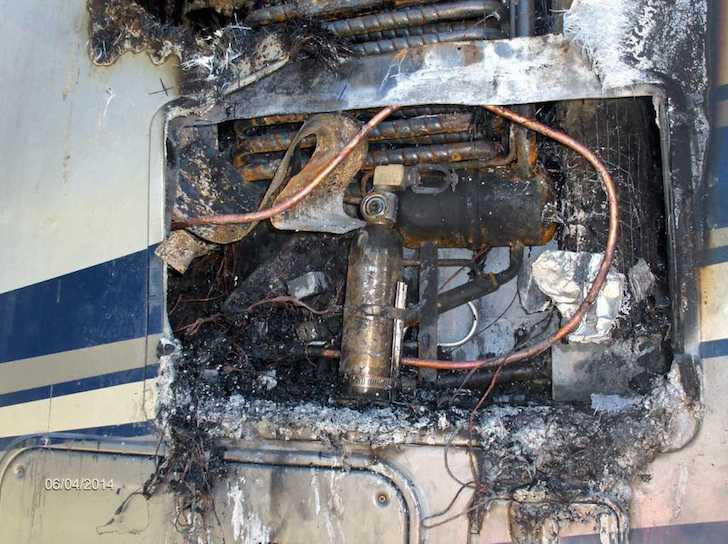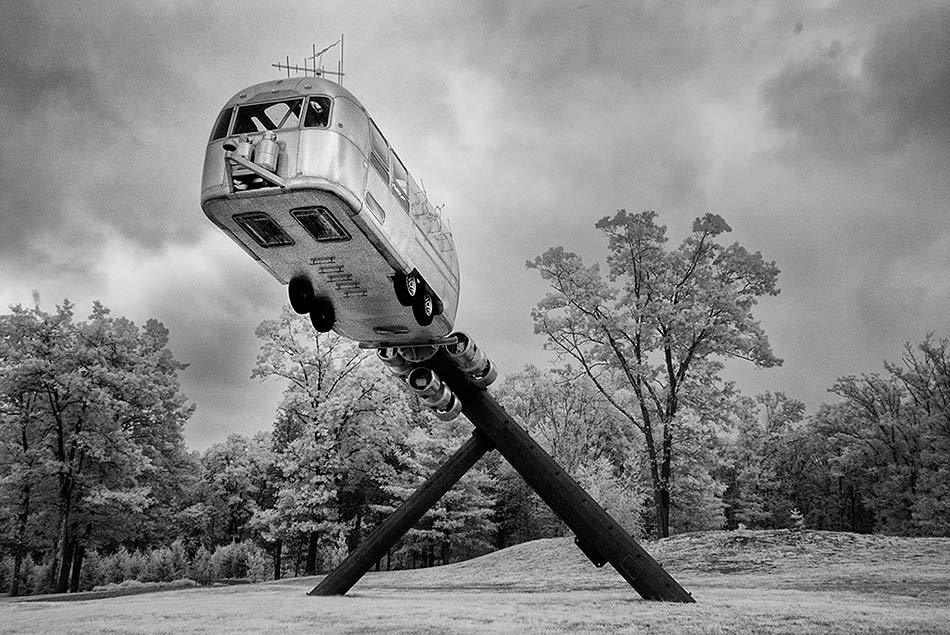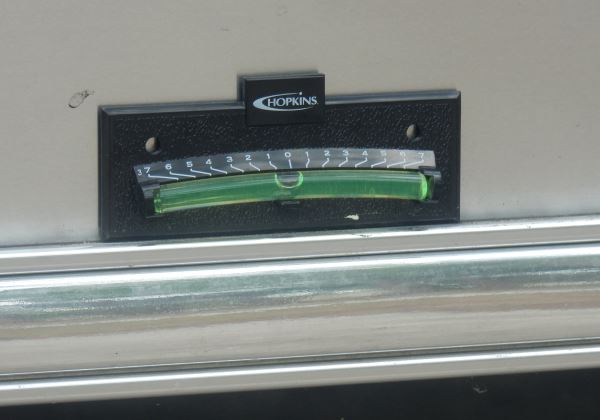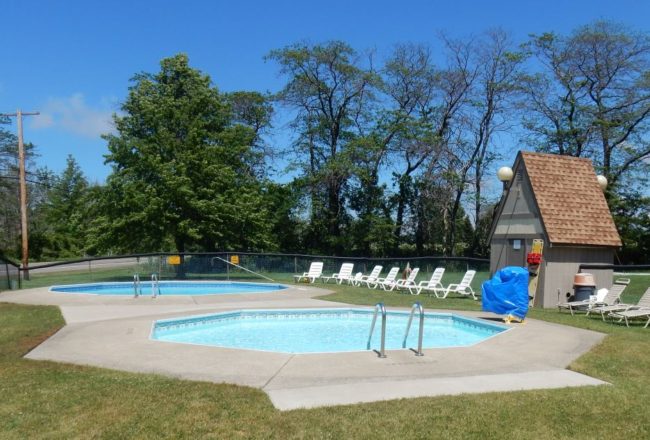When we bought our Airstream from the dealership they gave us a tiny little bubble level and a bit of advice. “Getting your trailer level is important,” they told us, “the furnace and the fridge won’t work right if it’s too far off true.” They also told us to use the bubble level in a few different places to make sure we got it all just right. Since that time, we’ve leveled our trailer a hundred times or so and I thought I’d share a few things we have learned.
How important is it to level out your Airstream?
It can be more important than you might imagine. The key reason for this is the refrigerator used in most RVs. They are called Absorption Refrigerators. They work by evaporating the refrigerant using heat. The refrigerant then re-condenses and returns to the reservoir it evaporated from. They key here is it returns using the power of gravity. If you Trailer is too far off level, it cannot properly return to where it needs to be.
This causes two problems with your fridge. Firstly, it stops making things cold which will result in spoiled food. Secondly, it can lead to the evaporation unit overheating to the point where it could catch your trailer on fire. While there is no guarantee you will end up burning down your trailer, it has happened to a good many people who discovered this the hard way. A quick google search can show you the result in horrifying detail.
This is also the reason you should turn off your fridge when you are on the road and should never just leave it on for long periods if you are not occupying your trailer.
There are other reasons beyond your fridge, though they are less dire. Trailers are somewhat flexible so if it is sitting at an angle some things might not fit like they do while it is level. Rivets can pop out, doors can fail to close true, furniture can get cracked and so on. Most trailers are designed with some give in them, but you don’t want to push things. Finally, it’s just nicer to be in a level trailer. Trail can seem to detect fairly minute deviations from true that I am incapable of noticing and I can attest she is not fond of them.

Exhibit A in why it is important to level your trailer! I couldn’t quite bear to show you the melted Airstreams.
Side-to-Side & End-to-End
There are two directions you can level your Airstream. To level it end to end, you use the jack at the front of your trailer. This will pivot you on the axels under the wheels. This is a pretty simple and straight forward process.
Leveling side to side is a little less convenient. What you need to do is to drive your trailer up onto some kind of leveling block that sits under your wheels on the side that is too low. Our Airstream dealer gave us a set of interlocking plastic blocks for this task. We have the Tri-Lynx brand and they work nicely for the task. The new hotness, however, are these Andersen levelers which both level the trailer, and work as wheel chocks. (Chocks keep the trailer from rolling forward or backward.) What makes them cool is the curved shape gives you a full range of heights as where the blocks can only take you up in increments of the size of the blocks. The downside is they cost a fair bit more, especially if you have double or triple axels. Also, if you only level one axel you run the risk of overloading. I suggest balancing on all axels for safty.
What you should not try to use to level your trailer are the four stabilizers you winch down when you park. They are not designed to lift up your trailer, only to keep it from wiggling around once it is in place. You want to get your trailer all leveled out before you deploy them and you want to tighten them firmly, but not so firmly that they shift the trailer. Crank on them too hard and you can undo the leveling you just did and possibly damage the stabilizers.

Here are the two types I mentioned. The arch ones give you perfect leveling while the blocks are also good for your jack and stabilizers.
How to Know it is Level
The reason I wrote this article is that we recently changed how we measure how level our trailer is. For quite a while we used the tool that the dealer gave us when we got the trailer. It’s a small square bubble level about a half inch on a side. We were taught to take that inside the trailer, find some fairly central, flat surface, and see where the bubble lies. It was recommended we try it in the fridge and on the kitchen counter top.
This technique and tool had a number of small problems. The tool itself is so small, that it is hard to get a really clear reading on just how level you are. The second issue has to do with those stabilizers I mentioned above. You don’t want to put them down until the trailer is level, but you have to go inside the trailer to use the little bubble level. If you go inside the trailer before the stabilizers are down, you shift around the trailer and thus muck up your measurement of it. Sometimes a little, sometimes a lot. Also, it is inconvenient to jump in and out of the trailer to do the measurements. The result was our level often wasn’t quite right. Good enough to be safe, but not enough to satisfy Trail. That means bringing up the stabilizers and having another go at the somewhat flawed process.
There was also a small level bubble on the power jack, but it was nearly useless. Its small size, coupled with its position at the far end of the trailer made it about useless for getting a precise measurement. Worse, the jack case it is on can wiggle around a good deal and as a result, it’s a better indicator if the jack case is level than the trailer itself.
Our solution was to get buy these Hopkins exterior bubble levels. They have an adhesive back so you can stick them to the trailer on the outside. This means you don’t have to enter the trailer to check your level, which in turn means it is faster and more accurate. They also have a bigger range on the level so it is easier to get a precise read of if you are on the mark exactly. Finally, you can’t lose them because they are glued to your trailer. So far, they have stayed on just fine through heavy rain and gale force winds.
You do need to make sure you get them stuck on such that they are marked level while the trailer is level. My wife first made sure that the trailer was level using a bubble leveler inside the trailer before attaching them. Occasionally, she’ll still double check them with another level to make sure they’re still true.







4 Comments
Hi. Just learning and first camp out @ Birch Point Campground, Island Falls, Me. was oy veh. After reading this (thank you- No stabilizer-jacks- not level and made me motion sick. No hot water, heat went out and wondering if that caused a fuse short as one side of lighting on my 1977 27 ft land yacht went out after the heat stopped working on the 2nd day. Hot water never worked but had water in from hook up. Think so? What stabilizers and jacks do you recommend?
Thanks So Much,
Joi Z Exit 9 🙂
It’s surprising how much difference it can make. My wife can tell if the trailer is even just a tiny bit uneven or unstable.
If you just need stabilizers, these are very easy to work with and pretty inexpensive: https://amzn.to/2IPyKiR
For a jack for the front of the trailer, that is a lot more dependent on what your trailer is. You want something rated for the right weight and which will be nice and stable for the mount on the front of the rig. You can get a hand crank operated one (which is much cheaper) or a battery powered one. Most of them require some work to install. You can get one that is not attached to the trailer, but it is significantly less stable that way so I don’t recommend it.
Where did you stick the levels? I know you said right along the trim, but where on the trailer?
We put the side to side one on the front of the trailer, mid center. It’s behind the propane tanks but easy to see as you walk up to it.
The end to end one is a few feet past our entry door on the starboard side of the trailer. Not quite half way down the length.
Hope that helps 🙂